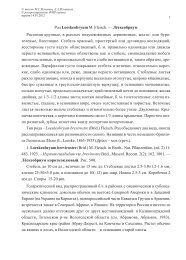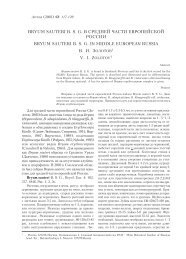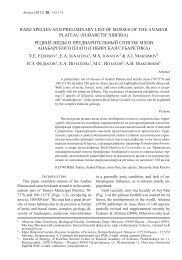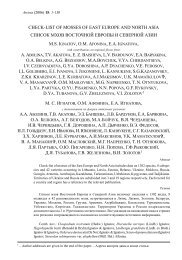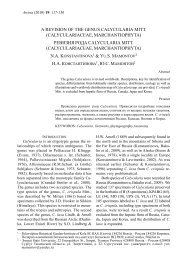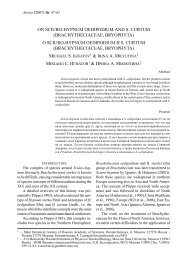THE GENUS BRYUM (BRYACEAE, MUSCI) IN MIDDLE ... - Arctoa
THE GENUS BRYUM (BRYACEAE, MUSCI) IN MIDDLE ... - Arctoa
THE GENUS BRYUM (BRYACEAE, MUSCI) IN MIDDLE ... - Arctoa
You also want an ePaper? Increase the reach of your titles
YUMPU automatically turns print PDFs into web optimized ePapers that Google loves.
178<br />
wide, with ovate perforations along keel, below<br />
often fused and forming irregular gaps; cilia<br />
2-3, short, without appendicules, slightly finely<br />
papillose. Spores 20-28 μm, brownish.<br />
Differentiation: Bryum knowltonii resembles<br />
B. amblyodon in peristome characters, but<br />
has a peculiar appearance due to closely imbricate,<br />
concave leaves, and a percurrent or shortly<br />
excurrent costa. Also, B. knowltonii differs from<br />
other species in having an exceptionally low<br />
basal membrane.<br />
Habitat: no data.<br />
Specimen examined (2): Leningrad Prov.,<br />
Schlisselburg, [collector?] 8.VI.1875, Í301911 (H);<br />
Novgorod Prov., Andreev & Pigurnova #8, 8.V.1977<br />
(MHA).<br />
Bryum uliginosum (Brid.) B. S. G., Bryol.<br />
Eur. 4: 88 (fasc. 6-9. Monogr. 18). 1839. – Cladodium<br />
uliginosum Brid., Bryol. Univ. 1: 841.<br />
1827. Fig. 74<br />
Bryum cernuum (Hedw.) B. S. G., Bryol. Eur.<br />
4: 84. 1839. hom. illeg.<br />
Autoicous; antheridial shoots very short, with<br />
1-2 antheridia, arranged very close to perichaetium<br />
within the same group of comosely crowded<br />
and enlarged upper leaves; perigonial leaves<br />
ovate, margin plane, costa ending below leaf apex.<br />
Plants always in rather loose tufts 1.5(-2.0) cm<br />
high, green to olive-green or brownish-green, with<br />
dense tomentum, rhizoids brown or dark-brown, rather<br />
densely and finely papillose. Stem dirty-red, to 1<br />
cm long, loosely foliate, comose, subterminal shoots<br />
1-3, comose. Lower leaves ovate-lanceolate, 1.2-2.0<br />
mm long, 0.5-0.7 mm wide; costa shortly excurent<br />
or percurrent. Upper leaves spreading when wet,<br />
curved to contorted when dry, (3.0-)4.0-5.0(-6.0)<br />
mm long, 1.0(-1.5) mm wide, oblong-lanceolate to<br />
narrow-elliptic, widest at ca. 1/2 of leaf length, longly<br />
acuminate, narrowed towards insertion, non-decurrent;<br />
margin narrowly recurved to nearly plane,<br />
entire or above weakly serrulate; border distinctly<br />
delimited from lamina, 2-3-rowed, unistratose to bistratose<br />
at places, yellow to brown-yellow, formed<br />
by long, thick-walled cells; costa stout, red below,<br />
greenish-brown to reddish-brown above, percurrent<br />
to shortly excurrent. Laminal cells thin-walled, not<br />
porose, in upper leaf narrow, 70-80(-100) x 20 μm, in<br />
mid-leaf rhomboid-hexagonal to rhomboid, ca. 100<br />
x 30 μm, towards leaf base larger, 80-200 x 20-36 μm,<br />
variable in size from +rectangular to irregularly tetra-,<br />
penta- and hexagonal, green.<br />
V. I. ZOLOTOV<br />
Perichaetial leaves oblong to lanceolate, with<br />
plane margin, non-bordered. Seta 3-5 cm high,<br />
orange-brownish to red-brownish, not twisted<br />
when dry, below capsule arcuate. Capsule horizontal<br />
to pendulous, pale brownish to brownish<br />
or brown when open, 5.0-6.0 mm long, 1.5-2.0<br />
mm thick, clavate-pyriform to oblong-obovate,<br />
somewhat gibbosus, not or only slightly contracted<br />
below small oblique mouth when dry;<br />
neck longer than urn, curved, collapsed when<br />
dry. Operculum small, short conic, with short<br />
small beak, orange-brownish, glossy. Annulus 2-<br />
3-rowed. Peristome inserted at urn mouth, 500(-<br />
550) μm high. Exostome teeth curved in dry<br />
condition with upper teeth inserted in between<br />
endostome segments, at base 140(-150) μm wide,<br />
linear-lanceolate, from middle tapered into thin<br />
subulate upper part; at base brownish- to brownish-yellow;<br />
above hyaline; border 10-12 μm;<br />
median line zig-zag-shaped; fundus orange or<br />
not differing in color from teeth, 60-70 mm high,<br />
not broadened; ventral trabeculae 25-30, without<br />
longitudinal septae or with very few septae<br />
in different parts of tooth. Endostome loosely<br />
adherent to exostome below, as long as exostome<br />
or slightly shorter, yellowish to yellow;<br />
basal membrane 1/2-4/4 of endostome length;<br />
segments broad, half-segment at base to 60 μm<br />
wide, +broadly perforate below (sometimes perforations<br />
fusing and forming big gaps), split<br />
along keel above; cilia 3, very short to nearly<br />
absent, finely papillose. Spores 28-32 μm, brownish-olive.<br />
Differentiation: When sporophytes are<br />
present, B. uliginosum is peculiar in having:<br />
(1) a long curved capsule with a narrow oblique<br />
mouth; (2) the endostome weakly adherent<br />
to the based of the exostome; (3) short,<br />
narrow cilia; and (4) narrowly perforate segments.<br />
Sterile plants of B. uliginosum are similar<br />
to those of B. pallens without red pigmentation;<br />
however, differentiating features of the<br />
former are large upper leaves, to 5-6 mm long,<br />
and very long basal leaf cells.<br />
The type of B. uliginosum was described by<br />
Demaret & Wilczek (1983).<br />
Habitat: Both collections are from wet<br />
clayish soil, one from springy place with<br />
Marchantia.<br />
Specimens examined (2): Moscow Prov. Zickendrath<br />
#402 & #988, LE.



